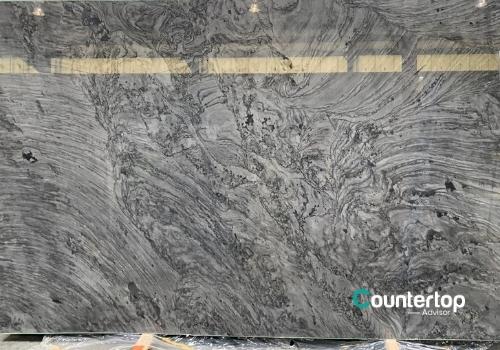
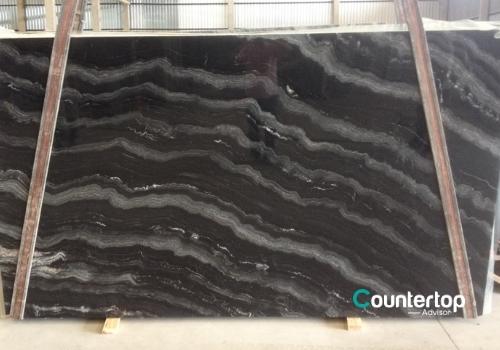
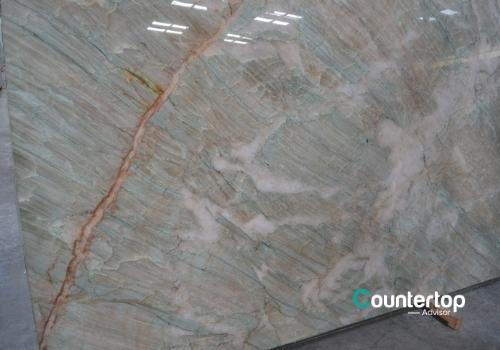
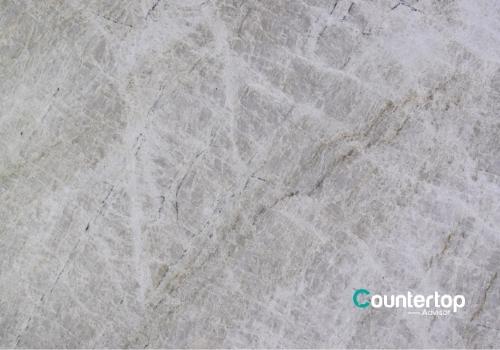
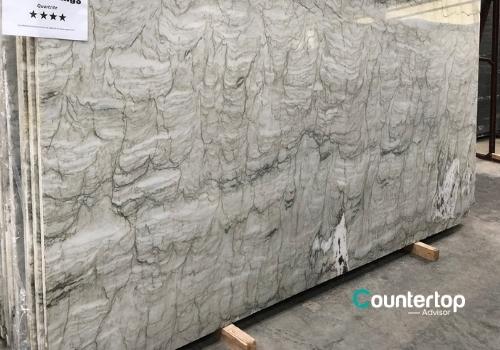

Quartzite is offered in a variety of finishes. Each type of finish creates a different look and feel in your kitchen or bathroom. When deciding on the countertop finish option that you want, you should consider how you will use your countertops, the overall design of your home, and how much light you want to be reflected back into your space.
Both finish types have wonderful benefits. If you want a bright area that looks pristine, you may want to choose a polished finish. Conversely, if you are worried about scratching or etching a honed surface may be a better choice.
No matter which finishes you choose, there are measures that you can take to reduce the risk of scratching and etching. For example, using a cutting board and never sliding heavy items across the countertop can reduce the risk of scratches. The risk of etching can be reduced with a high-quality quartzite sealer.
A sealer also helps reduce the risk of staining; however, there are no sealers that can guarantee your countertop will not stain. Spills still must be cleaned up when they occur. A polished countertop does offer a little more stain resistance than honed countertops. Unlike a honed surface that has open pores and is more susceptible to stains, polishing closes many of the pores in the stone and provides a natural barrier to stains.
Quartzite can be cut into a number of edge profiles. The edge profile that you choose can change how the countertop looks and feels. For example, an ogee edge profile creates an elegant and classical look. This edge pulls the eye to the edge, where the contrasting colors are more pronounced. Ogee edge profiles are great on rounded and organic shapes in the kitchen and bathroom.
Waterfall edge profiles are very popular in contemporary kitchens. The waterfall edge is typically done on kitchen islands; however, they can also be done at the end of the row of cabinetry. With this edge profile, the countertop extends to the floor, creating a bold statement.
The triple pencil edge produces a thicker edge and is best when coupled with bold design elements like heavy cabinet hardware, attention-grabbing light fixtures, or dark-colored countertops. The polished standard countertop works in traditional and contemporary homes. This classic shape features a flat front. Polished standard countertop edge profiles allow your countertops to blend in seamlessly, allowing you to accent your favorite dishes, appliances, etc. on your countertops.
Quartzite is a beautiful natural stone that is an excellent alternative to marble countertops. The colors and veining present in quartzite are similar to marble; however, quartzite is much more durable than marble. Quartzite countertops and backsplashes are beautiful in the kitchen and bathroom. Yet, these countertops also have a few disadvantages that should be considered when shopping for countertops.
Quartzite countertops are resistant to many common kitchen liquids. Cleaning quartzite is similar to granite countertops. Use a soft cloth and dust the countertops daily. Every time you use the countertops or spill something on them, you will need to wipe them down with a damp cloth and a small amount of dishwashing liquid. After the counters have been wiped down, rinse them using a clean wet cloth and dry with a paper towel.
Another option is to use a countertop cleaner formulated for stone countertops like Method Granite and Marble Cleaner Spray. With this cleaner, there is no need to rinse. Simply spray your cloth until it is damp, give your countertop a quick wipe, and viola clean countertops!
Citrus based cleaners, vinegar, or abrasives can damage the surface of the countertop. The acidic properties in these cleaners can destroy the sealer, causing your countertop to become dull looking and vulnerable to stains.
If a stain occurs, make a paste of baking soda and water or use a commercial stain removing poultice. Apply a thick layer of paste to the stain and cover the area with plastic wrap. Allow the paste to sit overnight. Wipe the paste away and rinse using a damp cloth. If any trace of the stain remains, repeat the application until the stain is gone.
Quartzite is formed when sandstone is placed under pressure and heat deep within the earth. The sandstone crystalizes and forms interlocking crystals that make quartzite durable and hard.
However, these crystals can have pores (spaces) between the interlocking crystals. These pores can allow liquids to seep into the stone and cause stains. Applying a quartzite sealer to your countertops can help decrease the porosity of the stone and help reduce the risk of stains. For the best results, the sealant should be applied annually.
Topical stone polishes contain acrylics, natural waxes, or polyurethanes. The application of these sealers is simple; however, they can wear quickly. Topical stone sealers like Stonetech Professional Stone Polish protects your countertops. This neural p-H formula is a gentle and water based, making it an excellent choice for countertops. To use simply spray the surface down with the stone polish, spread the polish with a cloth evenly, and then buff to a brilliant shine.
A penetrating sealer that contains silicates penetrates the stone surface and seal pores to repel water. This type of sealer lasts much longer than spray on polishes. Miracle Sealants Impregnator provides an invisible barrier to protect against staining. The formula is UV resistant, which means it will not yellow when exposed to sunlight. Once the impregnating sealer has fully cured, it is food safe. However, for best results, always use a cutting board when chopping food and a hot pad or trivet when placing hot pots and pans on the countertop.
Although quartzite countertops are durable, over time, your countertop can develop holes, chips, cracks, and discolorations. If this occurs, the quartzite can be honed and polished by a countertop specialist. The countertop specialist will use diamond polishing pads to remove discolorations and dullness. If any chips, cracks, or holes remain, the professional will use a specialized epoxy to fill in these areas. Finally, once the epoxy has dried, the stone specialist will polish the countertop to blend the patch.
Quartzite is an excellent alternative for marble countertops. Quartzite is approximately ten times more durable than marble and costs roughly half the price of marble countertops. The average cost of quartzite countertops is $90 per square foot. There are inexpensive quartzite countertops that run as low as $50 per square foot and expensive countertops that run as much as $120 per square foot.
The variation in cost is due to two factors. First, how rare the coloration and veining of the slab of quartzite can affect the price. Secondly, the price is determined by where you live. For this reason, homeowners cannot go by price alone when determining the quality of the stone countertop.
In addition to the cost of materials, labor costs can vary greatly. If you live in an area that does not have any countertop specialists who have experience installing quartzite countertops, you may need to hire a stone specialist crew from another city, which can increase the labor costs substantially.
Finally, the installation costs can be affected by the difficulty of the installation. If you have numerous corners or unique shapes, it will take more skill and more time to install the quartzite countertops. Furthermore, the edge profile chosen can affect installation costs. Intricate edges like the ogee edge require additional expertise and time to create. Conversely, simple edge profiles like a bullnose or square edge are much simpler and, therefore, less expensive.
Quartzite is the answer to homeowners looking for a countertop that is durable and can withstand the demands placed on it in a kitchen. If you love the look of marble but do not want the upkeep and maintenance required by marble countertops, quartzite is a great alternative.
Quartzite is extremely hard, which means you will be unable to cut the slab for yourself. A stone fabricator is needed to design and fabricate your countertops. Because quartzite countertops are extremely heavy, the installation should be left to a team of countertop specialists. If the countertop is not appropriately handled, the countertop could break, making it necessary for an entirely new piece of countertop to be ordered and fabricated.
Most stone yards will carry a few varieties of quartzite. However, some stone yard may mistakenly label quartz or certain types of marble as a quartzite. In order to determine if the slab you are looking at is quartzite, get a sample, and try to scratch the surface with a knife. Quartzite should not be able to be scratched by a knife blade.
Once you have chosen a quartzite slab, you will need to find a countertop specialist. Contact a few countertop specialists’ companies in the area and get a quote. * Tip – A high quality countertop specialist will want to come to your house to measure your countertops and look for any potential problems that may arise. Once you have found a countertop specialist and the measurements have been taken, your quartzite countertop will be fabricated according to your exact specifications. Once the countertop has been manufactured, your stone specialist will install your countertops.
Quartzite countertops are beautiful and provide you with a durable surface. The countertop will not yellow when exposed to sunlight. Additionally, once sealed, a quartzite countertop will repel most liquids, reducing the risk of staining.